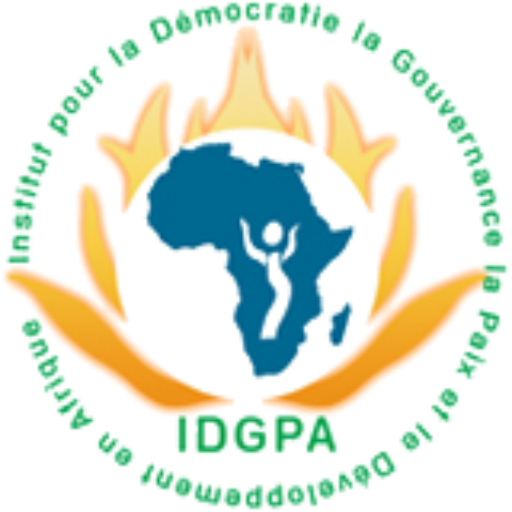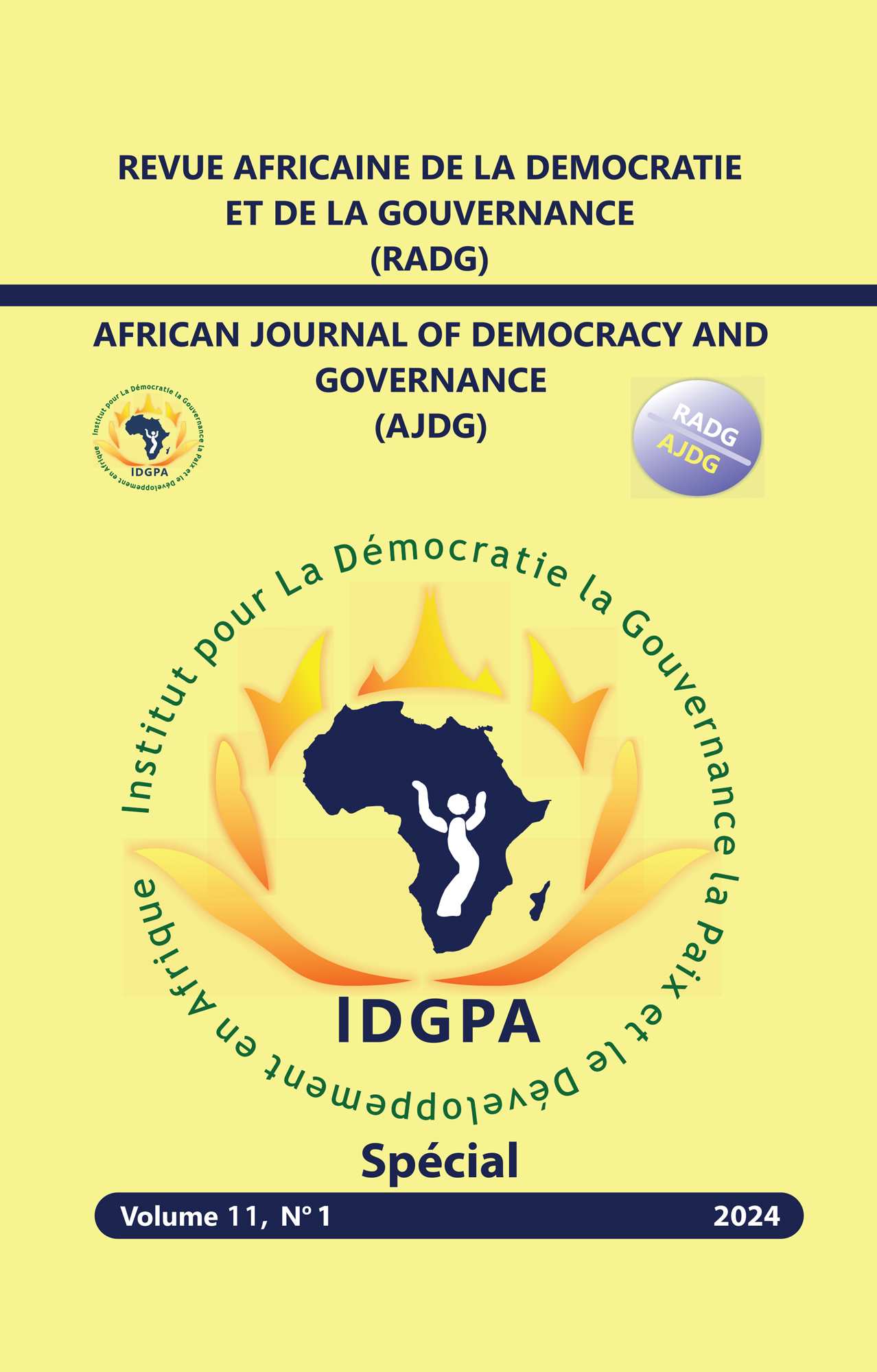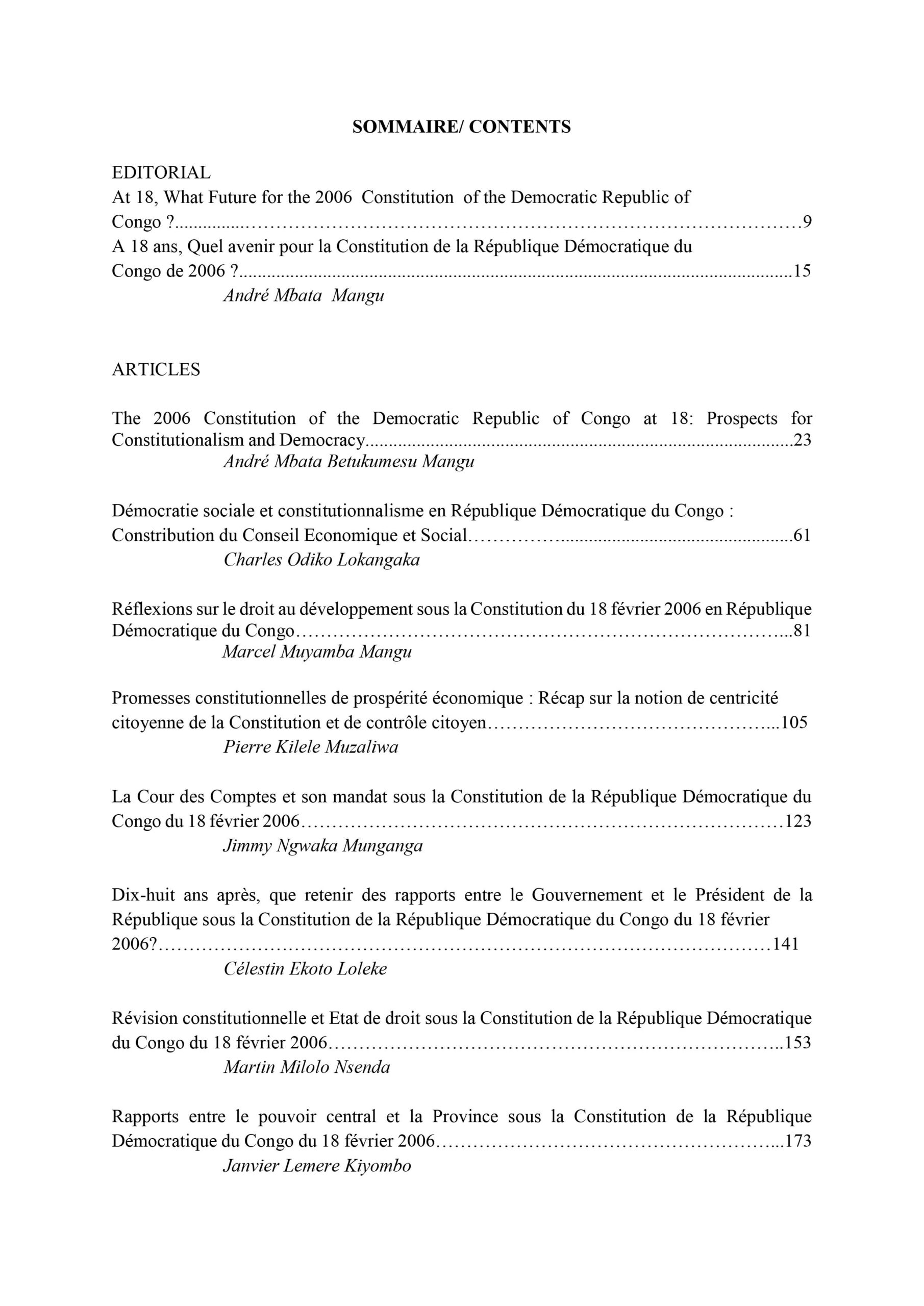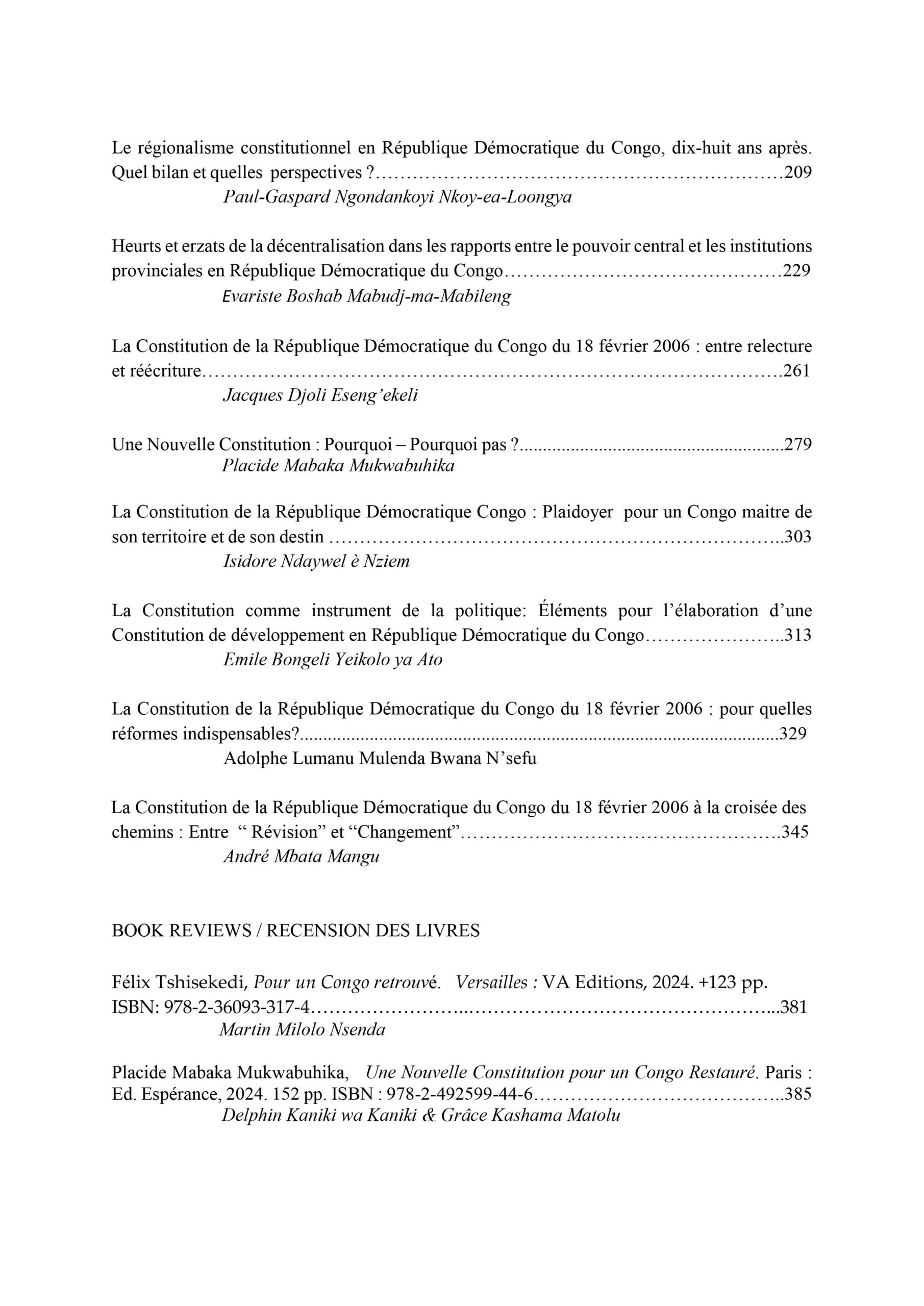Une Nouvelle Constitution : Pourquoi – Pourquoi pas ?
$ 10,00
Placide Mabaka Mukwabuhika, Professeur des Universités (Université du Kwango, Université Protestante au Congo, Université Etoile de Lubumbashi), Secrétaire Général à la Recherche, Université Etoile de Lubumbashi, Chercheur Associé à l’Université Catholique de Lille, Avocat au Barreau de Kinshasa-Matete, République Démocratique du Congo
Abstract
Since its accession to Independence on 30 June 1960, the Constitution the Democratic Republic of Congo (DRC) has been in quest for constitutional stability. The Fundamental Law of 19 May 1960 was the first constitution of the country. However, the Fundamental Law was an interim constitution. On the 1st August 1964, the Congolese people adopted by referendum a new Constitution. This Constitution did not survive General Mobutu’s coup d’Etat on 24 November 1965. The Constitution of 24 June 1967 was the third Congolese Constitution, but the second to be approved by referendum. It was amended several times until Laurent-Desire Kabila seized power from President Mobutu’s regime in May 1997. The Inter-Congolese Dialogue was held in Sun City (South Africa) and brought together the belligerents and the leaders of civil society and adopted a transitional Constitution. This Constitution was replaced by the Constitution that was adopted by referendum in December 2005 and promulaguated by President Joseph Kabila on 18 February 2006. Le Dialogue-inter-congolais de Sun City (Afrique du Sud) qui réunit les belligérants et la société civile autour d’une même table produisit une constitution de la transition qui régit le pays jusqu’à l’entrée en vigueur de la Constitution qui avait été adoptée par referendum en 2005 et que Président Joseph Kabila promulgua le 18 février 2006. Eighteen 18 years after it came into force, this Constitution has shown its weaknesses and the DRC is in search for another Constitution. The article calls for a new Constitution for a “restored Congo”, a truly Congolese constitution that would respond to the legitimate expectations of the Congolese people and the future generations. Such Constitution should draw inspiration from the past and present constitutions of the DRC. The choice of the best method and some major innovations would constitute the points of rupture or departure from the current constitutional dispensation. The New Constitution will mark the beginning of the Fourth Republic.
Résumé
Depuis son accession à l’indépendance le 30 juin 1960, la République démocratique du Congo (RDC) est en quête de stabilité constitutionnelle. La Loi fondamentale du 19 mai 1960 était la première constitution du pays. Cependant, la Loi fondamentale était une constitution provisoire. Le 1er août 1960, le peuple congolais adoptait par référendum une nouvelle Constitution qui ne survécut pas au coup d’Etat du Général Mobutu du 24 novembre 1965. La Constitution du 24 juin 1967 était la troisième Constitution de la RDC, mais la deuxième à être adoptée par référendum. Elle fut révisée plusieurs fois jusqu’à l’accession au pouvoir de Laurent-Désiré Kabila qui avait renversé le Président Mobutu en mai 1997. Le Dialogue-inter-congolais de Sun City (Afrique du Sud) qui réunit les belligérants et la société civile autour d’une même table produisit une constitution de la transition qui fut remplacée par la Constitution qui avait été adoptée par référendum en 2005 et que Président Joseph Kabila promulgua le 18 février 2006. Dix-huit ans après son entrée en vigueur, cette Constitution a montrée ses faiblesses et la RDC est à la recherche d’une nouvelle Constitution. L’article constitue un plaidoyer pour une nouvelle Constitution pour un « Congo restauré », une Constitution véritablement congolaise qui correspondrait aux attentes légitimes du peuple congolais et des générations futures. Une telle Constitution devrait s’inspirer des anciennes constitutions et de la constitution actuelle de la RDC. Le choix de la meilleure méthode et quelques importantes innovations la différencieraient de l’armature constitutionnelle actuelle. La Nouvelle Constitution marquerait le début de la Quatrième République.
Description
Mabaka Mukwabuhika, P. « Une Nouvelle Constitution : Pourquoi – Pourquoi pas ? », African Journal of Democracy and Governance, Vol 11, No 1, 2024, pp 279-302
Placide Mabaka Mukwabuhika, Professeur des Universités (Université du Kwango, Université Protestante au Congo, Université Etoile de Lubumbashi), Secrétaire Général à la Recherche, Université Etoile de Lubumbashi, Chercheur Associé à l’Université Catholique de Lille, Avocat au Barreau de Kinshasa-Matete, République Démocratique du Congo
Abstract
Since its accession to Independence on 30 June 1960, the Constitution the Democratic Republic of Congo (DRC) has been in quest for constitutional stability. The Fundamental Law of 19 May 1960 was the first constitution of the country. However, the Fundamental Law was an interim constitution. On the 1st August 1964, the Congolese people adopted by referendum a new Constitution. This Constitution did not survive General Mobutu’s coup d’Etat on 24 November 1965. The Constitution of 24 June 1967 was the third Congolese Constitution, but the second to be approved by referendum. It was amended several times until Laurent-Desire Kabila seized power from President Mobutu’s regime in May 1997. The Inter-Congolese Dialogue was held in Sun City (South Africa) and brought together the belligerents and the leaders of civil society and adopted a transitional Constitution. This Constitution was replaced by the Constitution that was adopted by referendum in December 2005 and promulaguated by President Joseph Kabila on 18 February 2006. Le Dialogue-inter-congolais de Sun City (Afrique du Sud) qui réunit les belligérants et la société civile autour d’une même table produisit une constitution de la transition qui régit le pays jusqu’à l’entrée en vigueur de la Constitution qui avait été adoptée par referendum en 2005 et que Président Joseph Kabila promulgua le 18 février 2006. Eighteen 18 years after it came into force, this Constitution has shown its weaknesses and the DRC is in search for another Constitution. The article calls for a new Constitution for a “restored Congo”, a truly Congolese constitution that would respond to the legitimate expectations of the Congolese people and the future generations. Such Constitution should draw inspiration from the past and present constitutions of the DRC. The choice of the best method and some major innovations would constitute the points of rupture or departure from the current constitutional dispensation. The New Constitution will mark the beginning of the Fourth Republic.
Résumé
Depuis son accession à l’indépendance le 30 juin 1960, la République démocratique du Congo (RDC) est en quête de stabilité constitutionnelle. La Loi fondamentale du 19 mai 1960 était la première constitution du pays. Cependant, la Loi fondamentale était une constitution provisoire. Le 1er août 1960, le peuple congolais adoptait par référendum une nouvelle Constitution qui ne survécut pas au coup d’Etat du Général Mobutu du 24 novembre 1965. La Constitution du 24 juin 1967 était la troisième Constitution de la RDC, mais la deuxième à être adoptée par référendum. Elle fut révisée plusieurs fois jusqu’à l’accession au pouvoir de Laurent-Désiré Kabila qui avait renversé le Président Mobutu en mai 1997. Le Dialogue-inter-congolais de Sun City (Afrique du Sud) qui réunit les belligérants et la société civile autour d’une même table produisit une constitution de la transition qui fut remplacée par la Constitution qui avait été adoptée par référendum en 2005 et que Président Joseph Kabila promulgua le 18 février 2006. Dix-huit ans après son entrée en vigueur, cette Constitution a montrée ses faiblesses et la RDC est à la recherche d’une nouvelle Constitution. L’article constitue un plaidoyer pour une nouvelle Constitution pour un « Congo restauré », une Constitution véritablement congolaise qui correspondrait aux attentes légitimes du peuple congolais et des générations futures. Une telle Constitution devrait s’inspirer des anciennes constitutions et de la constitution actuelle de la RDC. Le choix de la meilleure méthode et quelques importantes innovations la différencieraient de l’armature constitutionnelle actuelle. La Nouvelle Constitution marquerait le début de la Quatrième République.
Mots-clés: Constitution ; Nouvelle Constitution ; République Démocratique du Congo ; Révision constitutionnelle ; Stabilité constitutionnelle
Seuls les clients connectés ayant acheté ce produit ont la possibilité de laisser un avis.




Avis
Il n’y a pas encore d’avis.